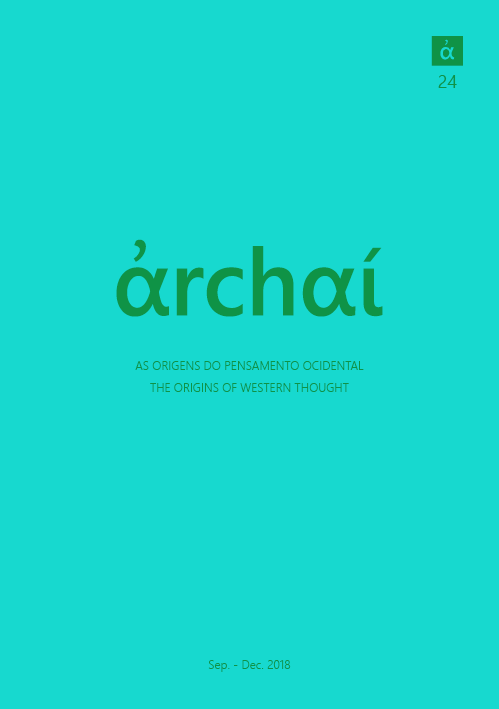On a finite and discrete algebraic model for educing space and movement from prime matter
DOI:
https://doi.org/10.14195/1984-249X_24_2Keywords:
metaphysics, ontology of matter, philosophy of nature, philosophy of physicsAbstract
In this paper we aim at presenting a finite and discrete algebraic model for the Aristotelian concept of substratum or prime matter (proté hylé), based upon further developments on this concept as carried out by Thomas Aquinas. Rather than considering it to be an outdated and obscure concept, it is shown how much profitable and current this Aristotelian insight is, both on the reality (yet not an individual) of a substratum that would pervade the whole of physical nature and on being the basic matrix for bodily genesis and corruption. This basic insight, despite of being a much controverted object over time, has been accepted by renowned authors, although in no way examined through any mathematical modeling. Additionally, it is essential that this substratum be endowed with qualities which allow the extraction of both space and bodily movement from itself. In this work, we present an algebraic model ex hypothesis isomorphic to the substratum, from which some relevant results like space extension and the dynamic character of matter are derived, and also a basic relation between operators which are obtained from dual vector spaces on the algebra and that provides the discrete case for Heisenberg’s uncertainty relations.
Downloads
References
BOHM, D. (1980). Wholeness and the Implicate Order. New York, Routledge & Kegan Paul.
BOSTOCK, D. (2006). Space, Time, Matter, and Form: Essays on Aristotle’s Physics. Oxford, Oxford University Press.
BYRNE, C. (1995). Prime Matter and Actuality. Journal of the History of Philosophy 33, nº 2, p. 197-224.
CLIFFORD, W. (1878). Applications of Grassmann’s extensive algebra. Am. J. Math. 1, p. 350-358.
CORREA, A. (1980). Tomás de Aquino. Suma Teológica. 11 vols. (tradução). Caxias do Sul/Porto Alegre, Livraria Sulina.
DAVIES, P. G. (1981). The Weyl Algebra and an Algebraic Mechanics. PhD Thesis. London, Birkbeck College, University of London.
FABRO, C. (2015). Participation et Causalité selon S. Thomas d’Aquin. Louvain, Parole et Silence.
FAITANIN, P. (2001a). Principum Individuationis: Estudio Metafisico de la Doctrina de la Individuación en Tomás de Aquino. Tesis Doctoral. Pamplona, EUNSA.
FAITANIN, P. (2001b). Ontologia de la materia en Tomás de Aquino. Cuadernos de Anuario Filosofico 135. Pamplona, EUNSA.
FAITANIN, P. (2009a). Tomás de Aquino. Os Princípios da Natureza. Opúsculos Filosóficos. (tradução, introdução e notas). São Paulo, SITA Brasil.
FAITANIN, P. (2009b). Tomás de Aquino. A Natureza da Matéria. Opúsculos Filosóficos. (tradução, introdução e notas). São Paulo, SITA Brasil.
FAITANIN, P. (2009c). Tomás de Aquino. A Mescla dos Elementos. Opúsculos Filosóficos. (tradução, introdução e notas). São Paulo, SITA Brasil.
FAITANIN, P.; VEIGA, B.; PETRONIO, R. (2014). Tomás de Aquino. A criação, a conservação e o governo do mundo. (tradução, introdução e notas). Campinas, Instituto Aquinate/Ecclesiae.
GILL, M. L. (1992). Aristotle on Substance: The Paradox of Unity. Princeton, Princeton University Press.
GRAHAM, D. (1987). The Paradox of Prime Matter. Journal of the History of Philosophy 25, nº 4, p. 475-490.
HESTENES, D.; SOBCZYK, G. (1987). Clifford Algebra to Geometric Calculus. Dordrecht, D. Reidel Publishing.
LANDAU, L.; LIFCHITZ, E. (1966). Mécanique Quantique. Moscou, Editions Mir.
MESCHINI, D.; LEHTO, M.; PIILONEN, J. (2006). Geometry, pregeometry and beyond. (Disponível em http://arxiv.org/abs/gr-qc/0411053v3).
NASCIMENTO, C. A. R. (1998). Tomás de Aquino. Comentário ao Tratado da Trindade de Boécio ”“ Questões 5 e 6. (tradução e introdução). São Paulo, Editora da UNESP.
NUSSENZVEIG, H. M. (1998). Ótica, Relatividade Física Quântica. Curso de Física 4. São Paulo, Edgard Blücher.
ODILÃO MOURA, D. (1977). Tomás de Aquino. Compêndio de Teologia. (tradução, comentários e notas). Rio de Janeiro, Editora Presença.
ODILÃO MOURA, D. (1981). Tomás de Aquino. O Ente e a Essência. (tradução, comentários e notas). Rio de Janeiro, Editora Presença.
ODILÃO MOURA, D.; JASPERS, L.; DE BONI, L. (1990). Tomás de Aquino. Suma contra os Gentios. 2 vols. (tradução e introdução). Rio de Janeiro, Editora Presença.
O’ROURKE, F. (2005). Pseudo-Dionysius and the Metaphysics of Aquinas. Notre Dame, University of Notre Dame Press.
ROWAN, J. (1961). Thomas Aquinas. Commentary on Aristotle’s Metaphysics. (translation). Notre Dame, Dumb Ox Books.
SOKOLOWSKI, R. (1970). Matter, elements and substance in Aristotle. Journal of the History of Philosophy 8, nº 3, p. 263-288.
VAZ Jr., J.; ROCHAR Jr., R. (2012). Álgebras de Clifford & Espinores. São Paulo, Editora Livraria da Física.
WEYL, H. (1949). Philosophy of Mathematics and Natural Science. Princeton, Princeton University Press.
WEYL, H. (1950). The Theory of Groups and Quantum Mechanics. Mineola, Dover.
WICKSTEED, P. H.; CORNFORD, F. M. (1957). Aristotle. The Physics. 2 vols. Cambridge, Harvard University Press.
Downloads
Published
How to Cite
Issue
Section
License
Given the public access policy of the journal, the use of the published texts is free, with the obligation of recognizing the original authorship and the first publication in this journal. The authors of the published contributions are entirely and exclusively responsible for their contents.
1. The authors authorize the publication of the article in this journal.
2. The authors guarantee that the contribution is original, and take full responsibility for its content in case of impugnation by third parties.
3. The authors guarantee that the contribution is not under evaluation in another journal.
4. The authors keep the copyright and convey to the journal the right of first publication, the work being licensed under a Creative Commons Attribution License-BY.
5. The authors are allowed and stimulated to publicize and distribute their work on-line after the publication in the journal.
6. The authors of the approved works authorize the journal to distribute their content, after publication, for reproduction in content indexes, virtual libraries and similars.
7. The editors reserve the right to make adjustments to the text and to adequate the article to the editorial rules of the journal.



